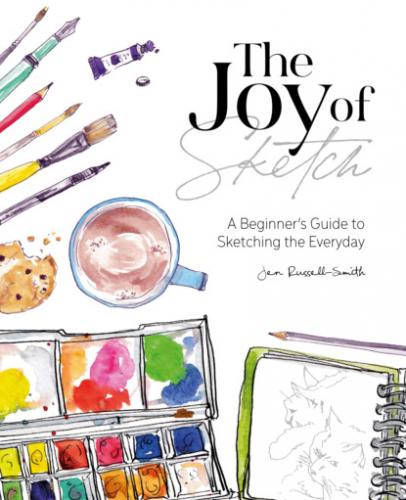The wonderful thing about filling a whole page is also that the sum ends up being more impressive than the parts… there might be some dodgy bits or smudgy bits or wonky bits but, somehow, when they’re covering a whole piece of paper, all those bits are less noticeable.
This is also a really good way to familiarize yourself with your materials, so do come back to it again if you get a new pen or sketchbook or something else you want to try. You can find out how the ink flows, how it sticks to the paper, how quickly it dries (to avoid smudging it) and just whether it feels comfortable in your hand.
So… just fill a page! My example here is just rows of shapes and patterns, many of which are my natural ‘doodling while on the phone’ scribbles. I like the way they seem to have turned into something a bit like a sweater pattern… Don’t think about it too hard, just pick a corner (or the middle) make a start and don’t stop until you run out of paper. If you end up covering the whole page with the same shape, that’s fine. A page of circles painted blue could turn into a cloud of bubbles, a page of triangles could be a pine forest? I drew a few lines before running out of ideas, so repeated them all in the opposite order and then did it again...
Stick with ink, or add some colour if you’ve got the time and want to see what happens. The most important thing, though, is not to stop until your page is completely full.
And look, before you even know it, you’re another page into that sketchbook!
Getting
STARTED
PRACTICALITIES
So, you’ve got your pen and your sketchbook or paper, and you’ve hopefully filled the first couple of pages with your colour chart and doodles. Now is a good time to look a little more closely at some of the practicalities of sketching with your materials.
As I mentioned when thinking about choosing your pen, whether or not your ink is waterproof will be a big feature of how you approach your sketches, along with how long it takes to dry. The waterproof ink I use takes quite a while to dry, and even longer to be fully waterproof, so I know that if I work too quickly, I’ll probably smudge it. Look back at the last couple of exercises and think about whether your ink dried straight away or if you had to leave it a few minutes? I sometimes complete a sketch and then come back to it later (or even another day) to add the colour. This actually works well if you’re working around other activities, or time is precious.
If you’re working with non-waterproof ink, a good approach can be to add paint first, and then draw over the top. The leaves here were painted this way – a quick sweep of the green, a bit more paint detail once that had dried, then a few ink lines over the top. You can also see that I smudged it!
I’m aware watercolour might seem like an odd choice of paint for quick, contemporary results – it’s got a bit of a reputation for ultra-traditional, wishy-washy landscapes and florals. But it’s also quick to use, lively (wet paint has a life of its own), eminently portable and easy to clean up. And while it might not have quite the depth or strength of colour you get with oil paint or acrylics, it’s still possible to create a vibrant splash on the page.
I’m not going to go into a huge amount of detail about watercolour painting – it would need a book for itself, and there are plenty out there once you’ve made a start! The key thing to remember is that wet colours will run together. But if you add one colour and allow it to dry, you can then add another with a sharper line between. Watercolour paint, on the page, is also translucent – you’ll see any previous colours through it and they will mix to create a new shade even when they’re dry.
TIP: CHOOSING COLOURS
Most watercolour palettes will come with a range of paint already included (usually a warm and a cool version of each colour), which are great for making a start. Over time, it will be quite obvious which colours you prefer (they’ll run out fastest) and which you avoid, and you can make a choice about adding more of your preferred shades and getting rid of the ones you don’t like. Or perhaps you could be brave and challenge yourself to use the neglected ones?
Конец ознакомительного фрагмента.
Текст предоставлен ООО «ЛитРес».
Прочитайте эту книгу целиком, купив полную легальную версию на ЛитРес.
Безопасно оплатить книгу можно банковской картой Visa, MasterCard, Maestro, со счета мобильного телефона, с платежного терминала, в салоне МТС или Связной, через PayPal, WebMoney, Яндекс.Деньги, QIWI Кошелек, бонусными картами или другим удобным Вам способом.
